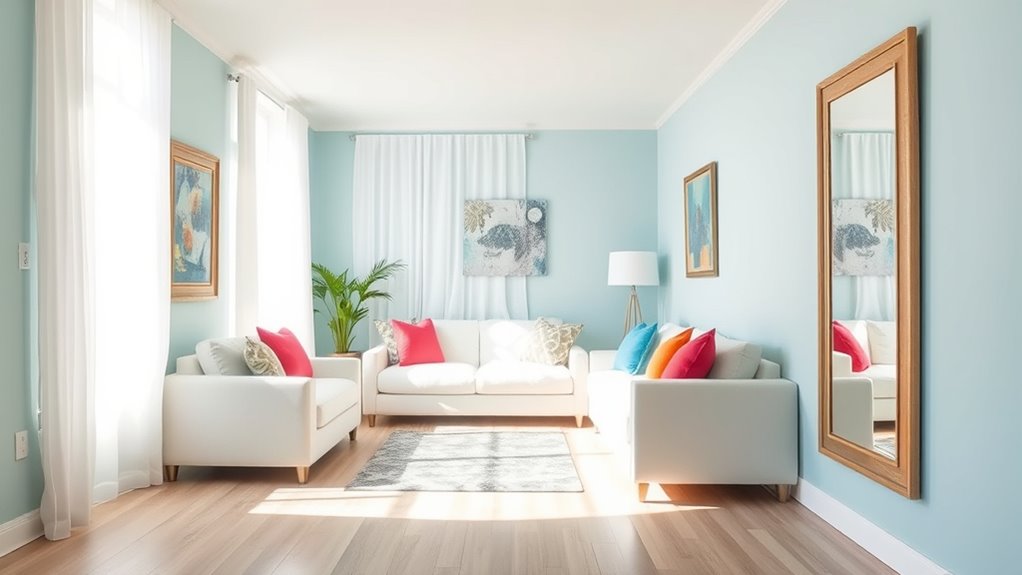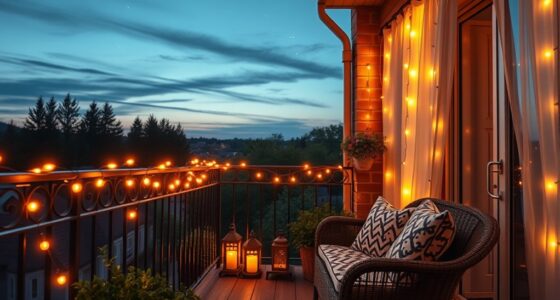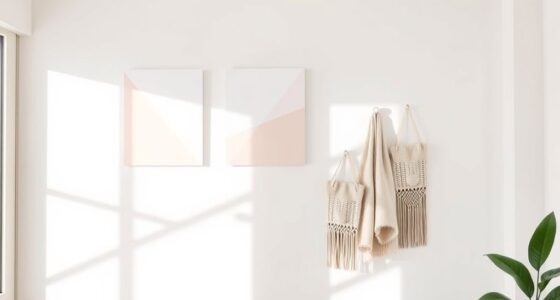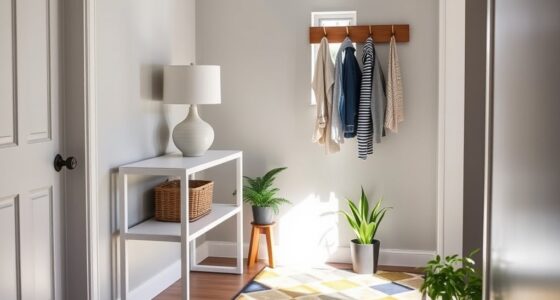To make small spaces feel bigger, use light, neutral, and reflective colors like whites, soft blues, and greens to bounce light around the room. Incorporate mirrors opposite windows or at eye level to amplify brightness and create depth. Add an accent wall with a bold or warm hue to create visual interest, but keep the rest of the walls light to maintain openness. Using the right sheen and simple decor enhances the spacious feel—learn how to balance color and design effortlessly.
Key Takeaways
- Use light, neutral, and reflective colors to bounce light and create an open, airy feel.
- Incorporate bright accent walls with bold or warm hues to add depth without shrinking space.
- Keep décor minimal and simple, emphasizing color contrasts to enhance perceived room size.
- Utilize mirrors opposite windows or at eye level to maximize natural light and visual expansion.
- Apply semi-gloss or satin finishes with light colors to reflect more light and amplify spaciousness.
The Best Light and Neutral Colors to Expand Your Space
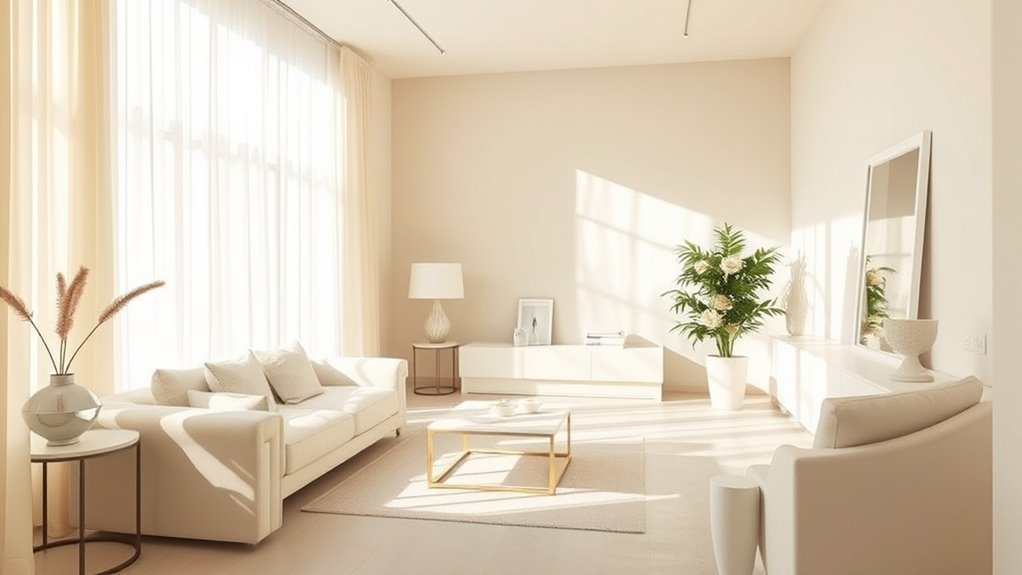
Choosing the right light and neutral colors can make a small space feel much larger. Light colors like Swiss Coffee OC-45, Acadia White OC-38, and White Chocolate OC-127 bounce light around the room, creating a sense of openness. Neutral shades such as off-white and soft whites—like Benjamin Moore’s Simply White or Farrow & Ball’s White Tie—offer a clean, bright look that visually expands your space. Pale blues like Smoke 2122-40 and gentle greens such as Silken Pine 2144-50 contribute to an airy, open atmosphere by receding in the room. When selecting paint choices, opt for finishes like satin or semi-gloss, which reflect more light, amplifying the feeling of spaciousness. Incorporating light colors into your decor can also help in maximizing vertical storage solutions and reducing clutter, further enhancing the perception of space. Additionally, choosing versatile paint shades that work well with various decor styles can make your space feel more cohesive and open. Using light reflective finishes can further increase the brightness in your room, making it appear larger. Incorporating appropriate lighting can enhance these effects and create a more welcoming environment. These subtle, light hues are your best allies for making a small space feel larger and more inviting.
How Accent Walls Can Create the Illusion of More Room
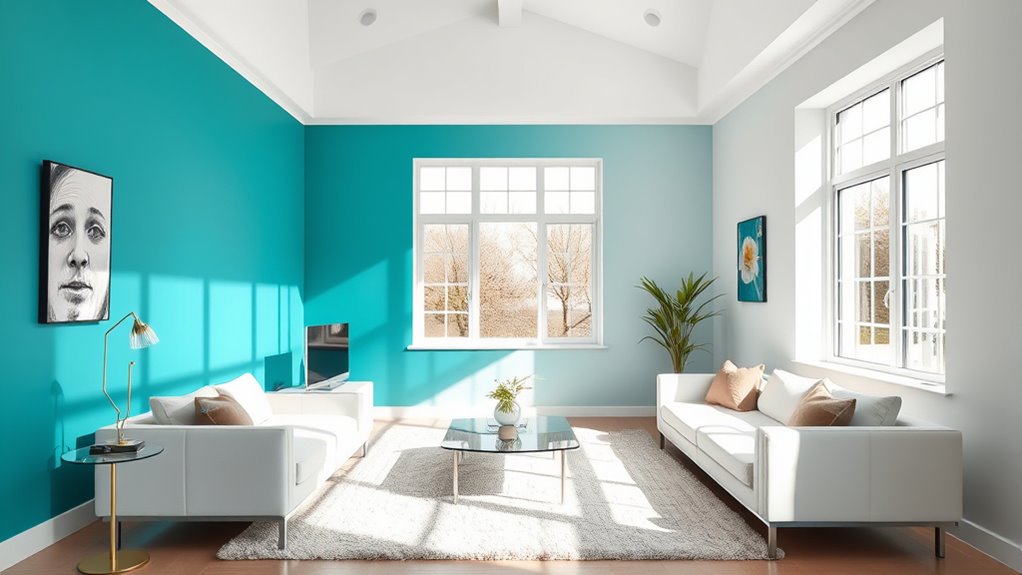
An accent wall painted in a bright, bold color instantly adds depth and draws attention, making your small space feel larger. Keep the other walls light and neutral to maintain an open feel, so the contrast enhances the illusion of roominess. Limiting décor on the accent wall prevents clutter, allowing the color to work its magic. Being aware of color psychology can help you choose hues that evoke openness and spaciousness, enhancing the overall effect. Additionally, considering popular anime movies can inspire vibrant color choices that energize your space and reflect your personality. Incorporating rustic decor elements can also add warmth and character to the room without sacrificing the sense of space. Emphasizing sustainable design choices can further contribute to a bright, airy atmosphere that feels inviting and harmonious.
Choose Bright Focal Colors
Adding a bright, focal color to one wall instantly draws attention and creates the illusion of more space. Bright colors, like Tomato Tango CSP-1145, make your accent wall stand out, adding visual interest and depth.
A bold, darker hue on one wall contrasts with lighter surrounding walls, enhancing the perception of space and preventing the room from feeling cramped. Selecting a color with high contrast against adjacent walls amplifies the room’s dimension, making it appear larger.
Keep décor minimal on the accent wall to emphasize the color and its spatial effect. Choosing a vibrant or warm hue as your focal point not only creates a striking visual feature but also tricks the eye into perceiving more room, making your small space feel more open and inviting.
Maintain Light Surroundings
Maintaining light surroundings around your accent wall enhances the illusion of space in a small room. Bright, light hues on the remaining walls help keep the environment open and airy, emphasizing the sense of spaciousness. When you choose a vibrant accent wall in a bold color like Tomato Tango CSP-1145, contrast is key; pairing it with lighter shades accentuates depth and dimension. This contrast tricks the eye into perceiving more room, making the space feel larger. Avoid heavy decor around the accent wall to prevent clutter, which can diminish the feeling of openness. Instead, focus on maintaining a bright, clean atmosphere that amplifies the visual impact of your accent wall. Incorporating visual perception techniques into your decorating strategy can further enhance the illusion of spaciousness. Incorporating cultural breakfast traditions into your morning routine can also add a lively and welcoming atmosphere to your home, further enhancing the feeling of spaciousness. With these simple choices, your small space will feel more expansive, lively, and inviting.
Use Minimal Decor
Keeping decor minimal around your accent wall helps maximize the sense of space in a small room. Minimal décor guarantees the accent wall remains the focal point, drawing attention and creating depth. A clutter-free environment prevents visual overload, making the room feel larger. Use simple accessories and limit decorative items to enhance the perception of openness. An understanding of symbolism in design can help you choose the most effective colors and elements for your space. An accent wall painted in a bold or bright color adds visual interest and can distract from limited square footage. Pairing a high-contrast or lighter hue with minimal décor emphasizes the wall’s impact without overwhelming the space. Ultimately, this approach maintains a clean, open feel, making your small room appear more spacious and inviting. Less clutter around the accent wall translates directly into a more expansive, airy atmosphere.
Brightening Small Areas: Alcoves, Nooks, and Windows
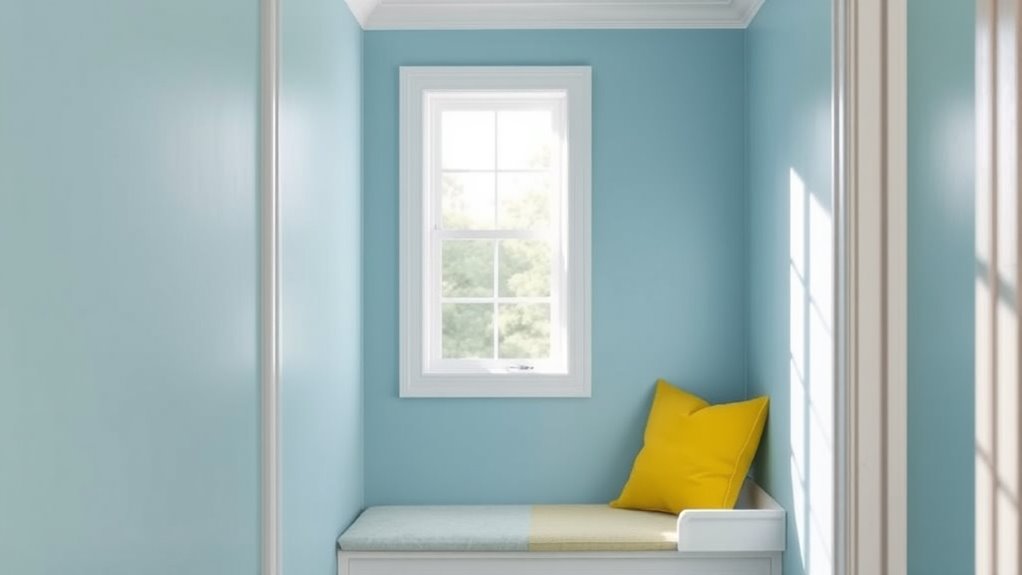
Brightening small areas like alcoves, nooks, and window recesses can dramatically enhance their sense of space. Using light-reflective paint shades such as Silken Pine or Raleigh Peach amplifies natural light and makes these small spaces feel larger. Applying pale, luminous colors on alcoves and small recesses creates an airy, open feeling by visually extending the area. Light hues bounce natural light around, brightening dark corners and reducing shadows. Incorporating reflective paint into your design can further boost the brightness and openness of these confined spaces. Additionally, choosing colors with high light reflectance can maximize the effect of natural and artificial lighting. Consistent, soft color palettes across architectural features like built-in shelves and window trims help prevent visual breaks, making the space appear seamless and more expansive. Being mindful of cybersecurity vulnerabilities when planning your color schemes can help safeguard your design files and digital assets from potential threats. Moreover, understanding the importance of home security systems can provide added safety, especially in areas where visibility and lighting are enhanced to deter intruders. Recognizing the need for proper equipment like paint sprayers can also ensure a smooth, even finish that enhances the overall brightness of your space.
The Power of Soft Yellows and Warm Hues in Small Rooms
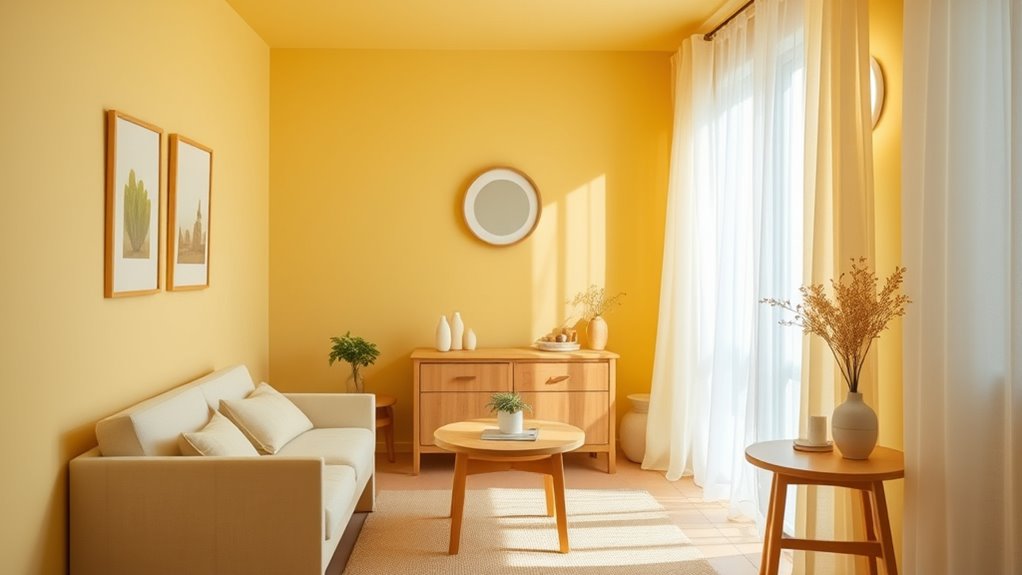
Soft yellows and warm hues can considerably enhance the sense of space in small rooms by reflecting light and adding a cozy, inviting atmosphere. These colors, like Angel’s Trumpet 278 and Cream Silk OC-115, bounce light around, making your space feel larger and brighter. Additionally, incorporating elements from best beaches such as light, natural tones can further amplify this spacious feeling. Muted yellow tones provide warmth and luminosity without overwhelming the room, creating an inviting vibe. Using yellow as an accent or pairing it with neutral hues boosts the perception of depth and openness. Yellow’s high light reflection helps brighten dim or windowless rooms, visually expanding the area. Understanding drivetrain components can help you optimize your space and lighting choices for maintenance or renovation. Incorporating color psychology principles can guide you in selecting hues that evoke the desired mood and perception of space. Moreover, choosing colors with variable hours in mind can assist in planning lighting strategies to enhance small spaces effectively. To maximize this effect, consider: – Incorporating soft yellows for better light reflection – Using warm hues to add cozy warmth – Combining yellow with white trims or lighter furnishings – Applying muted yellow tones for subtle luminosity – Enhancing perception of space with strategic color placement. Additionally, selecting colors with long-lasting vibrancy ensures your space remains bright and welcoming over time.
Choosing the Right Sheen and Finish for a Larger Feel
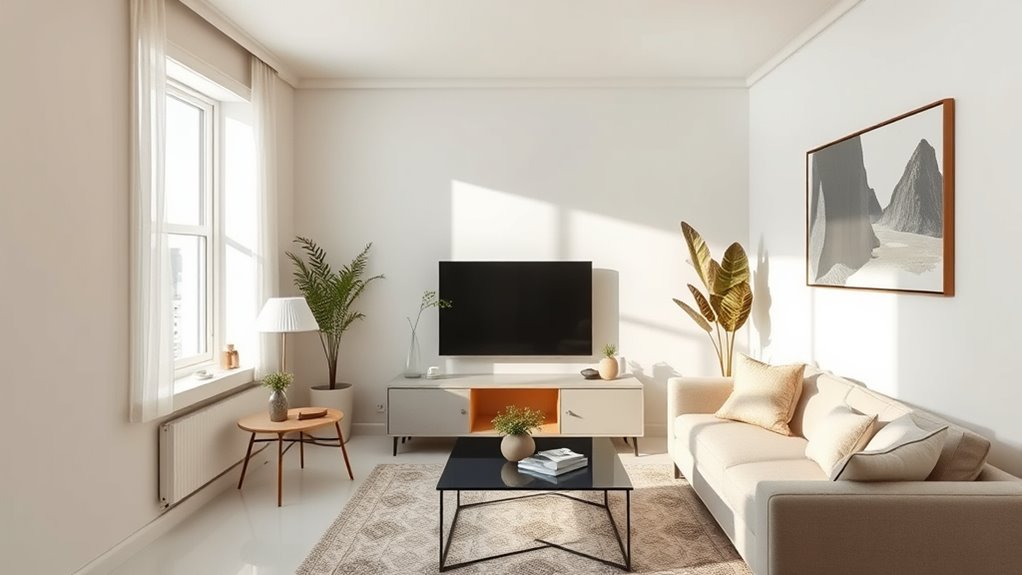
Choosing the right finish for your walls can considerably influence how spacious a room feels. A higher sheen, like semi-gloss or high-gloss, reflects more light, making your walls appear brighter and the room more open. Color temperature adjustments can also enhance the perception of space by influencing how warm or cool the room feels visually. Satin and eggshell finishes strike a balance between durability and light reflection, enhancing the spacious feel without excessive shine. In contrast, matte or flat finishes absorb light, which can make surfaces look dull and smaller—less ideal for creating the illusion of space. Using a consistent sheen across walls and ceilings creates a seamless, airy look that visually expands the room. Pairing a brighter, reflective finish with light colors maximizes natural and artificial light, making your small space feel more open and inviting.
Tips for Using Dark Colors Strategically in Compact Spaces
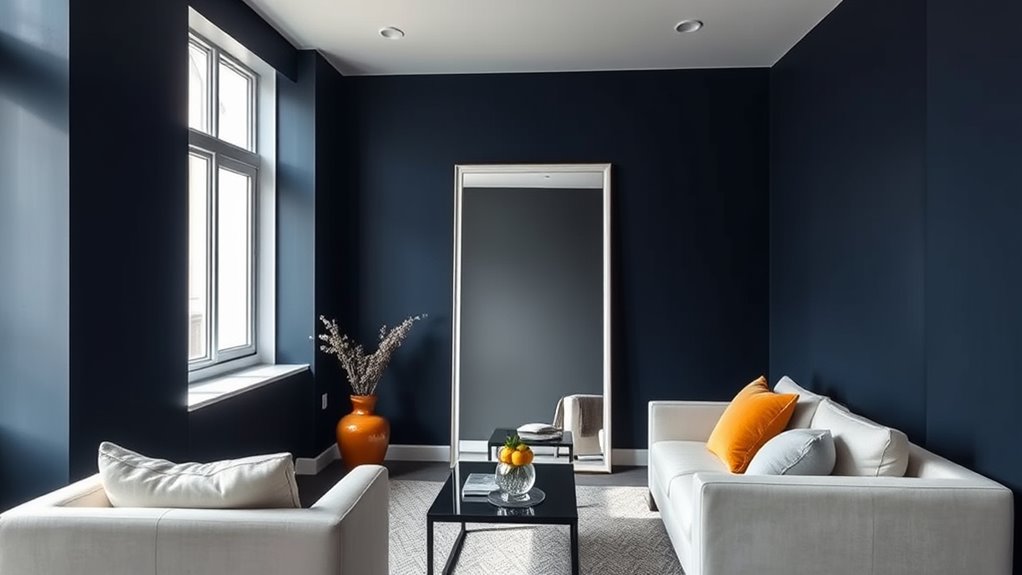
While dark colors can make a small space feel cramped if overused, strategic application can add depth and sophistication without sacrificing openness. To do this, focus on placing dark hues, like navy or charcoal black, on a single accent wall for contrast and visual interest.
Use dark colors sparingly on lower walls or through accessories to create a cozy vibe while maintaining a sense of openness. Pair dark hues with ample white trim or lighter furnishings to prevent enclosure.
Incorporate reflective surfaces, such as mirrors or glossy finishes, to enhance light reflection and balance the room’s perceived size. Additionally, painting ceilings a bright white or light neutral helps offset heaviness and makes the space feel taller.
These tips optimize dark colors without overwhelming your small space.
Enhancing Space Perception With Reflective Surfaces and Mirrors
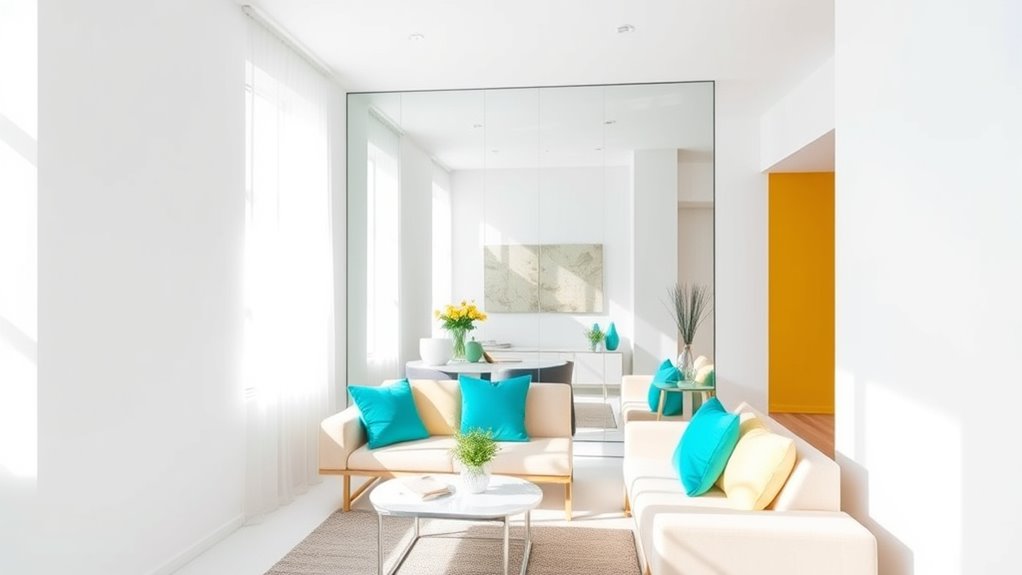
Placing mirrors thoughtfully can considerably expand your space by bouncing light and creating depth. Position them opposite windows or at eye level to maximize brightness.
Using reflective materials on walls or furniture further amplifies the sense of openness in your small room.
Mirror Placement Strategies
Strategic mirror placement can considerably enhance the perception of space in small rooms. By carefully positioning mirrors, you amplify light and create a convincing space illusion that makes your room feel larger.
Place large mirrors opposite windows to reflect natural light, instantly brightening the area and expanding the perceived room size.
Use mirrors behind bookshelves or cabinets to deepen the sense of space and reflect surrounding décor.
Incorporate mirrored furniture, such as coffee tables or sideboards, to add reflective surfaces that visually expand the room.
Position full-length mirrors near doorways or in corners to bounce light into dark areas.
Additionally, using multiple smaller mirrors with varied shapes distributes reflections throughout the space, increasing openness and making your small room feel more spacious.
- Large mirrors opposite windows for light amplification
- Mirrors behind shelves for depth enhancement
- Mirrored furniture to expand perceived room size
- Full-length mirrors near doorways or dark corners
- Multiple small mirrors with varied shapes for distribution
Reflective Material Benefits
Reflective materials like mirrors and glossy finishes are powerful tools for making small spaces feel larger. They work by amplifying light reflection, which brightens the room and creates a visual illusion of expanded space.
Placing mirrors opposite windows or light sources maximizes this effect, flooding the area with natural or artificial light. Reflective surfaces, including mirrored furniture and decorative accents, can visually double the perceived size without adding physical space.
Light-reflective materials also eliminate shadowed areas, making enclosed or dimly lit rooms feel more open and airy. Incorporating these reflective elements is a quick, effective way to enhance space perception, helping small rooms feel bigger with minimal effort.
This simple strategy leverages visual illusion to transform your space instantly.
Practical Color Combinations and Design Ideas for Small Rooms
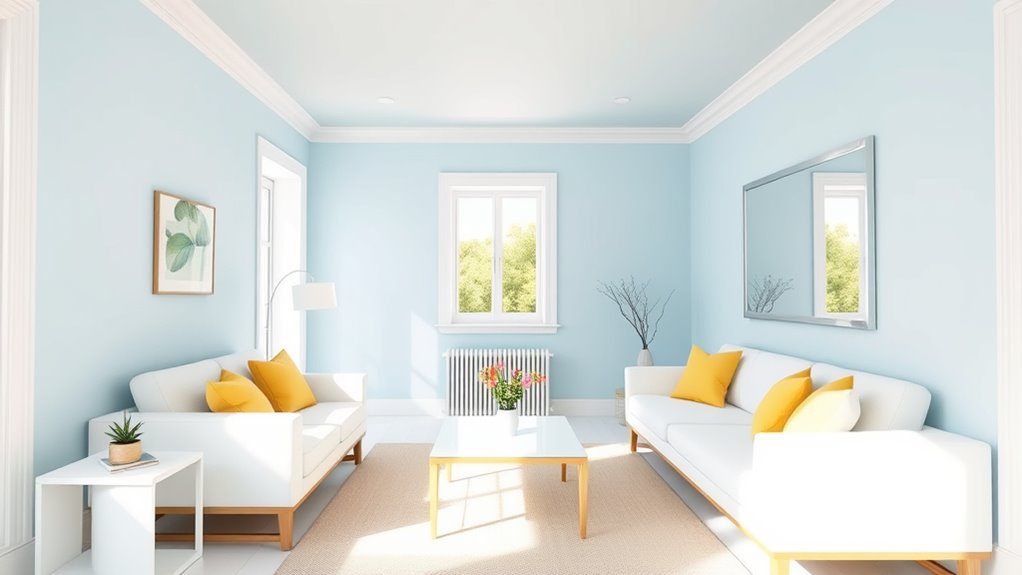
Wondering how to make your small room feel more spacious? Choosing the right paint colors and design ideas can markedly enhance the space feel.
To make a room look bigger, consider these practical color combinations:
- Pair light, airy shades like pale blues or soft whites with darker accents for depth.
- Use neutral hues such as off-white or greige, complemented by mirrors to amplify natural light.
- Opt for monochromatic schemes with varying shades of the same light hue, like blue or gray, for cohesion.
- Add an accent wall in bold, warm colors like Tomato Tango or deep blue to create visual interest.
- Combine complementary colors, such as pale green with white trim or soft lavender with brass accents, to brighten small rooms.
These tips will help you master interior design and optimize your space feel.
Frequently Asked Questions
How to Paint a Small Room to Feel Bigger?
When you want a small room to feel bigger, start by choosing light, airy colors like soft whites or pale blues to reflect natural light and create openness.
Paint the ceiling bright white to draw the eye upward, making the room seem taller.
Use semi- or high-gloss sheens to bounce light around, and add mirrors to enhance the feeling of space.
Avoid dark colors that can make the room feel more confined.
How Do You Make a Small Space Look Bigger?
Did you know that light colors can make a room feel up to 25% larger? To make your small space look bigger, choose airy shades like whites and soft neutrals.
Use mirrors to reflect light, and keep furniture scaled down and well-arranged to avoid clutter.
Painting ceilings white draws the eye upward, creating an illusion of height.
Keep décor minimal to maximize open, airy feeling.
What Is the Best Color for Small Spaces?
When choosing the best color for small spaces, opt for light, airy shades like whites, soft neutrals, or pale blues. These colors reflect natural light, making your space feel larger and more open.
Stick to a consistent palette to create a seamless look, and add reflective finishes to boost the sense of spaciousness.
Avoid dark or heavy hues, which can make your room feel cramped.
How Can One Use Color to Increase the Perceived Size of Furnishing Within a Space?
To make your furnishings seem larger, choose light, neutral colors like whites, beiges, or soft greys. Paint your furniture and walls in similar shades to create a seamless, continuous look that visually expands the space.
Opt for matte or soft finishes to reduce visual weight.
Adding bright or airy accent pieces draws attention upward and outward, further enhancing the room’s openness and making your furnishings appear less bulky and more integrated.
Conclusion
Think of your small space as a tiny garden. With the right colors and clever tricks, you’re the gardener tending to a lush, expansive landscape. Bright hues, reflective surfaces, and strategic accents are your tools to make every corner feel open and inviting. Just as a skilled gardener nurtures growth, you can cultivate a room that feels bigger, brighter, and full of potential—transforming your cozy space into a beautiful, airy sanctuary.
